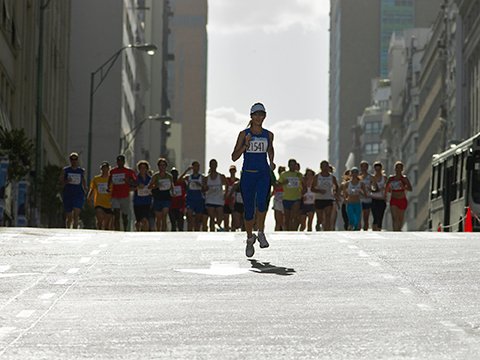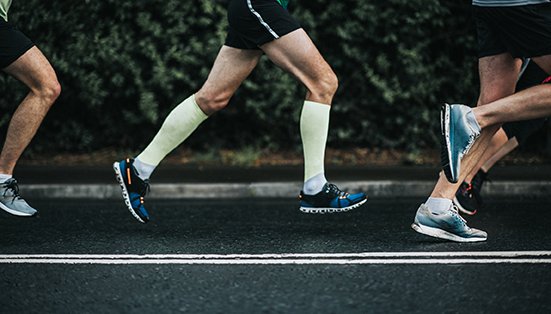How to Run Your First Ultra Marathon
What is an ultra marathon, you ask? If you are curious about how to train for an ultra marathon race, what gear and shoes you will need, or looking for tips on how to make your first ultra-marathon a success, Outdoors.com has the answers.
If you’re a runner looking for your next outdoor fix, you might naturally ask yourself: how long could I really run?
As humans, we continually chase improvement and strive for excellence. What will our next challenge or greater feat be? If you’re considering running your first ultra marathon or maybe you’ve been inspired by David Goggins, one of the best ultra-marathon runners in the world, and want to give it a try, then you are in the right place.
What Is An Ultra Marathon?
An ultra-marathon is a foot race that includes any race covering a distance longer than the distance of a marathon, which is 26.2 miles. The standard progression of ultra-marathon distances is 50k or 31 miles, 50 miles, 100k or 62 miles, to 100 miles.
That’s a wide, maybe limitless range of lengths, and ultra events reflect that. Races are generally unique in terms of length, difficulty, and terrain. Some of the most famous ultra marathons in the world cross incredible and breathtaking landscapes, like the Ultra-Trail Mount Fuji, but Mount Fuji, despite an incredible view of Fuji-san the whole way, has challenging climbing of up to 8000 m (26,000 ft).
Ultramarathon races can also be defined by time. In a time-defined race, the winner is whoever runs the farthest in that time period. There are generally three different time frames used for time-based ultra marathons: 6 hours, 12 hours, and 24 hours. The time it takes to run an ultra marathon will depend greatly on terrain and skill level. Most amateur runners use the technique of walking uphills and running downhills and flats to save energy. The longest ultramarathon race in the world is the Sri Chinmoy Self-Transcendence 3100 Mile Race which takes 52 grueling days to complete.
How to Train for an Ultra Marathon

If you’re considering becoming an ultra runner, the first step is selecting the length of the race you want to run. Start to increase both the time and distance that you run and a runner’s body will certainly follow. Start with 30 miles and move up to 50 miles or as close to your chosen race’s length as you can get.
The most significant difference between training for marathons and training for ultras is the back-to-back long-running. Marathon training is usually one long run per weekend, but ultra training plans typically have two long run days in a row on a training weekend to get used to running on tired legs.
Keep in mind that preparing for extended runs can be quite demanding on your time, so smart scheduling is your ally. Mixing in diverse activities, such as swimming or cycling can be helpful, but running should, of course, be the focus. Recovery from intense cardio can be challenging, so always remember to prioritize nutrition, hydration, and rest during both training and race days.
If you are tight for training time, try to spend more time on your feet during work, and through the day. This prepares the legs and body for long periods of being upright and can help build up supporting muscles in the legs to sustain long lengths of standing activity.
What to Eat During An Ultra Marathon
An ultra-marathon race is just as much an eating contest as a running contest, and a solid food strategy is the second most important part of running ultras. It should be designed to keep you hydrated and fuelled to keep energy up, and gut issues down. The strategy should be practiced as part of your overall training, so there are no surprises on race day.
Once you start an ultra marathon, try to eat within 45 minutes and continue to eat consistently. Throughout the race, there will be aid stations that provide food, hydration, and medical help if needed. Aid stations should have actual food, as the typical long-run staples like gels or chews won’t be enough. Sports drinks, dried fruits, fruit sauces, potato wedges, rice cakes, jerky, nut butter, and granola bars are all good on-to-go snacks and can help keep sodium, hydration, and calorie levels steady.
Ultra Marathon Gear
While being fit enough and training to gain a runner’s body may feel like the most important thing, the right gear can also be a race-changer. Underestimating gear selection and prep is a common mistake that first-time ultra-marathon runners make. And like food, incorporate your gear strategy into your training, so there are no race day surprises that will impact your performance.
Your first consideration might be socks. Toe socks can help eliminate friction. And you can probably guess, friction is not your ideal when you’re running 100 miles. Toe socks also help prevent blisters and allow your toes to improve balance and grip.

For your shoes, it’s important to break them in a bit, so wear any shoe you plan to wear on race day for at least two weeks beforehand to prevent foot pain. It can be helpful to have a support buddy at an aid station along the race that could supply a second pair of shoes if the soles of your shoes start giving away mid-race from persistent use. The right shoes make the biggest difference in how long you can run. You may wish to even get them professionally fitted. Keep in mind that your feet may swell at any point, so buying a pair of shoes slightly bigger may be necessary for comfort.
As you run for long distances, your sweat can turn to salt and rub and irritate your skin. Don’t wear any clothes that will cause additional discomfort or chafing. Prevent chafing with tricks such as taping your nipples and putting Vaseline on a popsicle stick to reach all the important skin-to-skin parts of the body, such as the armpits, the groin, and the butt cheeks.
Here is a list of key gear to consider for your first ultra marathon race:
- Quick dry short sleeve shirt
- Clothing with small pockets for snacks
- Lightweight wind shell or rain jacket
- Running shorts that won’t rub with minimal seams
- Hydration vest, like a camelback with a hydration mix to replace electrolytes
- A beanie or gloves, if it will be cold
- Trekking poles for difficult terrain, but remember, you have to keep carrying them unless you drop them off at an aid station
The ultra-marathon community is famously warm and welcoming, and completing an ultra-marathon is a transformative feat. If you properly build up your training, fuel yourself adequately to keep going, and outfit yourself with high-quality gear, you will be primed for your best performance and an amazing time.
Whether you decide to aim for the Ultra-Trail du Mont Blanc across France, Italy, and Switzerland, or just want to push your limits on an adrenaline-fueled trip Down Under at Ultra-Trail Australia, your first ultra-marathon is sure to create lifelong memories.
Ultras are built to challenge you both physically and mentally, and the ultimate reward will be realizing you are capable of so much more than you ever imagined.
Source: https://outdoors.com/how-to-run-your-first-ultra-marathon/







